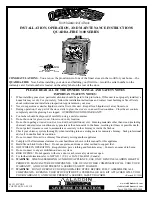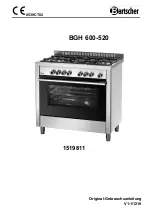
28
Place the fire lighters
between the upper sticks
INSTRUCTIONS FOR HEATING
ENVIRONMENTALLY FRIENDLY OPERATION
Avoid turning down your wood-burning stove to the point where no flames are
visible from the wood, as this leads to poor combustion and low efficiency. The
gases released from the wood will not be burnt off due to the low temperature
in the combustion chamber. Some of the gases will condense in the stove and
flue system as soot, and this could lead to your chimney catching fire at a later
point. The residual smoke which exits the chimney will pollute the surrounding
area and cause an unpleasant smell.
LIGHTING
We recommend the use of fire lighters, or similar products, which are available from your Scan dealer.
Using fire lighters helps light the wood more quickly and keeps the combustion process clean.
See our video about correct firing on www.scan-stoves.com or scan the QR-code. Please note
that this video is only intended as a guide. You should also follow the instructions in the specific
manual for your stove model!
NOTE: Never use liquid lighting fuels!
”TOP DOWN” LIGHTING
"Top down" lighting is a more environmentally friendly way of lighting the fire and helps to keep the glass area as clean as possible.
Do as follows for a correct ”top down” lighting:
¬
4 pieces of wood approx. 20-25 cm long with a weight of approx. 0.4-0.5 kg per piece.
¬
12-20 thin pieces of firewood of about 20-25 cm in length, with a total weight of approx. 1 kg.
¬
3-4 fire lighters
1
Place the pieces of wood, firewood and fire lighters in the combustion chamber as shown below
2
Set the combustion air control to maximum for 20-30 minutes (See "Instructions for use")
3
When the large pieces of wood have caught fire, you can adjust the combustion air to the desired level
NOTE: The wood must not cover the bottom entirely and must never be placed higher than the indication for max. load
(This does not apply at a cold start) (See Maintenance).
NOTE!
No matter how good your chimney is,
it will not perform well, if you do
not use it correctly. Equally, a poor
chimney may well give you acceptable
results, if you use it correctly
Scan the QR-code
and see our video
about correct firing.
USING THE STOVE IN VARIOUS WEATHER CONDITIONS
The way the wind affects the chimney can have a big impact on how your stove reacts under various wind loads; you may need to
adjust the airflow to achieve good combustion. Fitting a damper in the flue pipe may also help, as it will allow you to regulate the
draught under changing wind loads. The damper must not close more than 80% of the flue pipe.
Fog and mist can also have a big impact on chimney draught; you may need to use other settings for the combustion air to
achieve good combustion.













































